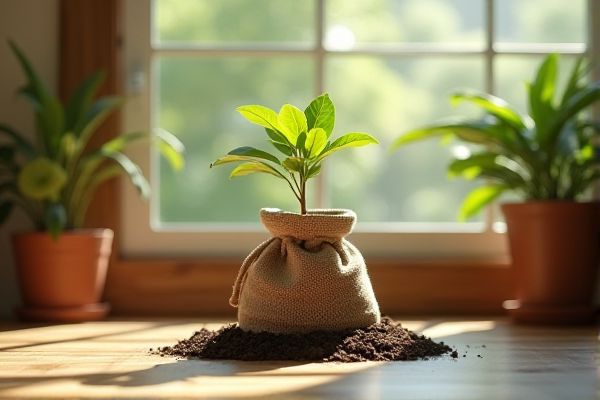
Root pouches promote healthier root growth by allowing air pruning and better drainage, reducing the risk of root circling common in plastic pots. Discover more about how choosing the right container can improve your plant's vitality in the rest of this article.
Table of Comparison
| Feature | Root Pouch | Plastic Pot |
|---|---|---|
| Material | 100% recycled, breathable fabric | Durable, non-porous plastic |
| Drainage & Aeration | Superior airflow and drainage | Limited drainage, may cause root rot |
| Root Health | Prevents root circling and promotes healthy growth | May cause root circling and stagnation |
| Weight | Lightweight and flexible | Heavier and rigid |
| Durability | Lasts 3-5 years with UV resistance | Can last many years but may crack in sun |
| Environmental Impact | Eco-friendly, made from recycled materials | Non-biodegradable, plastic waste concerns |
| Cost | Moderate initial cost, reusable | Lower upfront cost, less eco-friendly |
Introduction to Root Pouches and Plastic Pots
Root pouches offer breathable fabric construction that enhances aeration and prevents root circling, promoting healthier plant growth compared to traditional plastic pots. Plastic pots, made from rigid, non-porous materials, can restrict airflow and drainage but are often more durable and reusable for long-term planting. Choosing the right container impacts your plant's root development and overall vitality.
Materials: Fabric vs. Plastic
Root pouches use breathable, non-woven fabric that enhances aeration and promotes healthier root growth by air pruning roots, reducing root circling common in plastic pots. Plastic pots are made from solid, impermeable materials that retain moisture but often limit oxygen exchange, potentially causing root rot and poor drainage. Fabric root pouches provide better temperature regulation and moisture control compared to traditional plastic containers.
Breathability and Root Health
Root pouches offer superior breathability compared to plastic pots, allowing air to penetrate the fabric and promote healthier root systems by preventing root circling and encouraging air pruning. This enhanced airflow reduces the risk of overwatering and root rot, ensuring your plants develop stronger, more fibrous roots. Choosing root pouches supports optimal root health, improving overall plant growth and resilience.
Water Retention and Drainage
Root pouches offer superior water retention by using breathable fabric that allows excess moisture to evaporate while maintaining consistent soil hydration, reducing root rot risks. In contrast, plastic pots retain water longer but often lead to poor drainage and waterlogging, which can suffocate roots and hinder plant growth. The porous nature of root pouches enhances aeration and prevents overwatering, promoting healthier root development compared to traditional plastic containers.
Temperature Regulation
Root pouch containers offer superior temperature regulation compared to plastic pots due to their breathable fabric, which allows excess heat to escape and promotes cooler soil conditions. Plastic pots tend to retain heat, causing soil temperatures to rise, which can stress plant roots and inhibit growth. The enhanced ventilation in root pouches helps maintain stable root temperatures, improving plant health and reducing the risk of heat-related damage.
Environmental Impact and Sustainability
Root Pouches are crafted from biodegradable, recycled materials that reduce plastic waste and promote soil health, making them an eco-friendly alternative to traditional plastic pots. Unlike plastic pots that contribute to long-lasting pollution and landfill accumulation, Root Pouches decompose naturally, minimizing your environmental footprint. Choosing Root Pouch supports sustainability by encouraging responsible gardening practices and reducing reliance on fossil fuel-based products.
Durability and Longevity
Root pouches made from breathable, fabric materials offer moderate durability but may degrade within 2-5 years depending on environmental exposure, while plastic pots provide higher longevity, often lasting over a decade under proper conditions. Fabric root pouches promote healthier root growth by preventing root circling and improving aeration, but they tend to wear out faster due to UV exposure and moisture. Plastic pots resist weathering and physical damage better, making them ideal for long-term use in gardening and commercial nurseries.
Cost Comparison
Root pouches typically cost more upfront than plastic pots due to their fabric materials and durability. Plastic pots are generally cheaper and widely available, making them popular for large-scale or budget-conscious gardening projects. Over time, root pouches may offer better value by promoting healthier root systems and reducing the need for frequent repotting.
Plant Growth Performance
Root pouches enhance plant growth performance by promoting superior aeration and drainage compared to traditional plastic pots, reducing root circling and improving root structure. Studies show plants grown in root pouches exhibit increased biomass, healthier root systems, and better nutrient uptake. In contrast, plastic pots often restrict root expansion, leading to stunted growth and less efficient water use.
Choosing the Right Container for Your Plants
Root pouches provide superior aeration and drainage compared to plastic pots, promoting healthier root growth and preventing root circling. They are made from breathable fabric that encourages air pruning, which leads to robust root systems and improved plant vitality. Plastic pots, while durable and reusable, can retain excess moisture and limit oxygen flow, making them less ideal for plants sensitive to overwatering.
 homyna.com
homyna.com